
The pattern of maturation for American stained glass was similar to the progress of American portrait painting. The
Evert Duyckinck, Arms of
Rutger Jacobsen, about 1656,
leaded and painted glass,
Albany Institute of History and
Art. Photo: Daderotimported work of art, often commissioned during a visit to the mother country, England, France, or Spain, preceded the arrival of immigrant artists. Afterwards, the immigrant artist, and even the second generation, relied on printed sources of master works. For example, most of the limners had based their work on European mezzotints and Copley had copied prints of Renaissance artists. The stained glass designers, often anonymous, relied upon published drawings especially from Renaissance sources for figural images. Evert Duyckinck, a Dutch immigrant New York glazier of the 17th century continued to work in the mode of his origins.1 His production followed the tradition of Northern Lowlands heraldic badges that were painted with vitreous paint and enamel color on uncolored glass, invariably leaded in rectangular segments. European-inspired forms continued to dominate American markets well into the 1870s. Indeed, the New World was deeply connected to the Old. Given the considerable expense of glazed windows, only the more affluent clients were able to install stained glass. In the economic context of the time, this meant that the most likely patrons were Episcopal/Anglican churches, whose impetus was to affirm social, theological, and artistic connections with England.
Early beginnings and an antipathy for figural imagery
Model church with quarry glazing,
from John Henry Hopkins, Essay
on Gothic Architecture, 1836,
plate 20. The first stages of colored glazing in this country were modest. Exactly how modest is revealed by consulting the 1836 Essay on Gothic Architecture by John Henry Hopkins, Episcopal Bishop of Vermont.2 Bishop Hopkins was a firm supporter of stained glass to modulate light in order to produce an atmosphere conducive to prayer. Aware, however, of the limited technical and financial resources in this country, he suggested that "a very beautiful effect may be produced at small expense, by transparencies painted on linen or muslin in the Gothic style and fixed inside the windows."3 Hopkins' own church of St. Paul in Burlington had such stained glass substitutes until true stained glass was installed during a renovation campaign in 1851.4
Not simply expedience, but a general tendency to distrust imagery appears to have encouraged these choices in the first half of the century. Hopkins devoted a chapter in his Essay to the issue of pictures in churches. He carefully argued that "it would seem that . . . events (from Scripture) might lawfully be presented to the eye by pictures and statues, since these would assuredly aid to fix them in the memory."5 He concluded, however, that the danger of superstition and idolatry had been so great in the history of Christianity that on the whole he would recommend only "appropriate architectural enrichments, and . . . judicious and edifying selections from the word of God."6
The long tradition of grisaille glass in of Europe

York Minster, England, detail
of Five Sisters window,
north transept, about 1250,
Photo: author Even when architects used leaded glass, it was most commonly quarry glazing, small sections of glass in a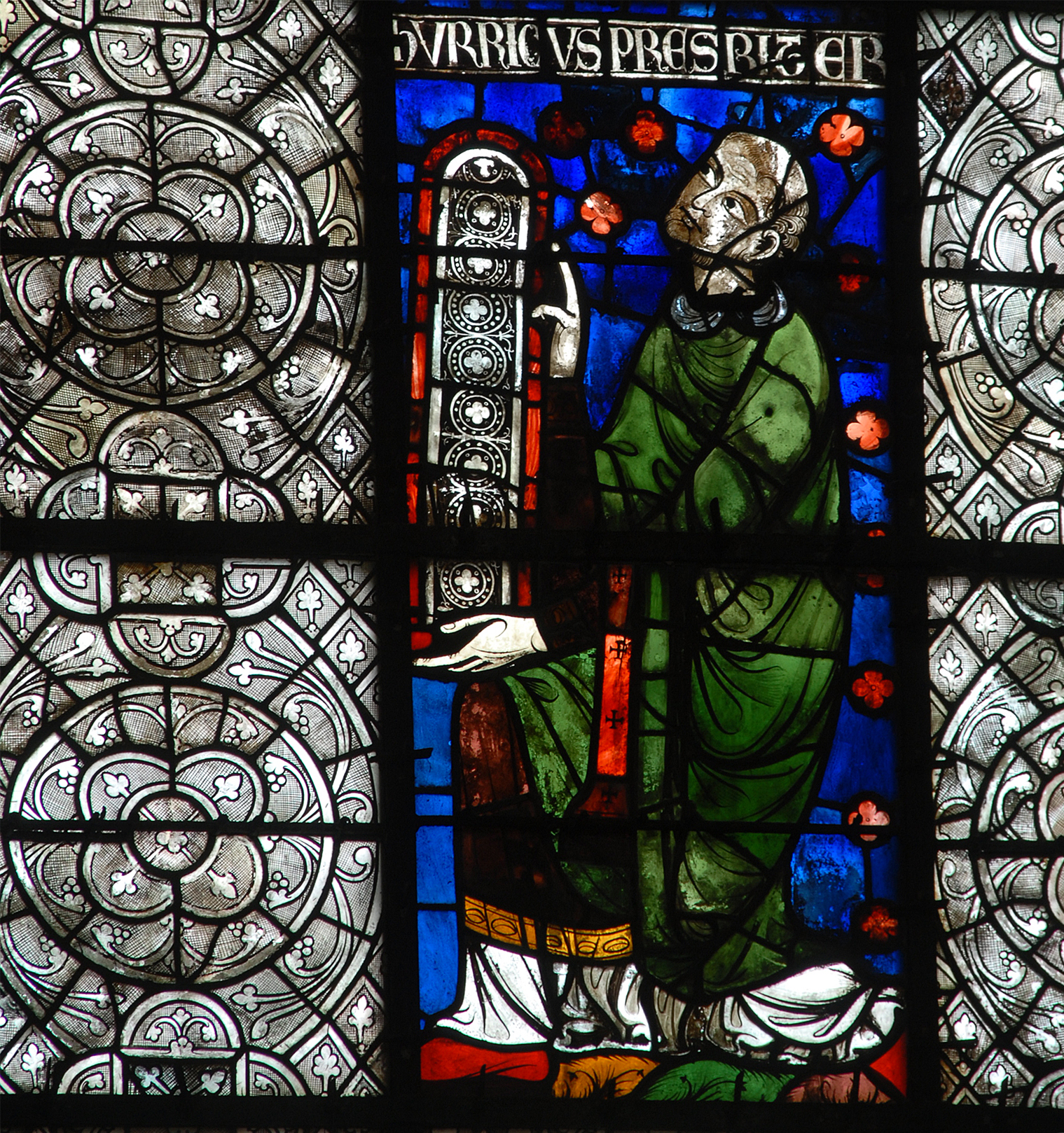
Cathedral of Auxerre, France, axial
chapel, donor, labeled Hurricus Presbyter,
offering a window, 1230s.
Photo: Michel M. Raguin lattice pattern, a style very popular in 14th and 15th-century English country churches and Tudor secular buildings. Indeed non-figural uncolored glass, generally referred to as grisaille, was quite common throughout the history of glazing. Grisaille allowed greater light and
Great Hall at Ockswells Manor,
Berkshire County, England, about 1460,
19th-century color lithograph.
Source: s7hauhe.wordpress.com was often used to frame subjects. At Auxerre Cathedral in France, the axial chapel displays narrative cycles with saturated color behind the altar, but grisaille at the sides. On the north, one of the windows dated to the 1230s, shows grisaille panels framing the Virgin and the donor, labeled Hurricus Presbyter, who offers a window. The north transept at York minster was provided with five huge lancets, completely in grisaille patterns. In place around 1250, the windows have suffered many invasive restorations so that their pattern is now difficult to perceive. It is important, however, to realize that one of the wealthiest sees in England selected an image-less installation in a highly prominent a place. As society transformed and secular persons achieved more economic power, individual homes installed glass. Most of these installations mingled some form of grisaille with the image. Often the choice was heraldic display, a concept quite similar to the work of Evert Duyckinck. The English tradition is exemplified by the glazing of
Ockwells Manor, a 15th century manor house in the county of Berkshire. Sir John Norreys, the owner was keeper to the Wardrobe of Henry VI. The windows in the great hall, dated to about 1460, present a series of coats of arms associated with Sir John’s family ties and sphere of influence.
Augustus N. W. Pugin’s influence on ecclesiastic reform and on the design of stained glass
Augustus Northmore Welby Pugin, possibly best known for his contributions to the design of England’s Houses of Parliament, was early interested in stained glass. His writings as well as his commissions were major forces in the development of Gothic Revival in England and its cultural extensions, particularly the United States. A pioneer in the taste for ecclesiastic embellishment, Pugin maintained a close supervision of the decorative aspects of his buildings, even designing and cartooning windows himself. For Pugin, a Roman Catholic convert, the Gothic style represented the rediscovery of the unity of man, nature, and God as understood by the Middle Ages.7 The dining room of his home was set with
August Welby Northmore Pugin,
designer, William Wailes, fabricator,
Pugin Coat of Arms and Moto, 1844,
The Grange Dining Room, Ramsgate,
Kent County, England.
Photo: Michel M. Raguin grisaille windows 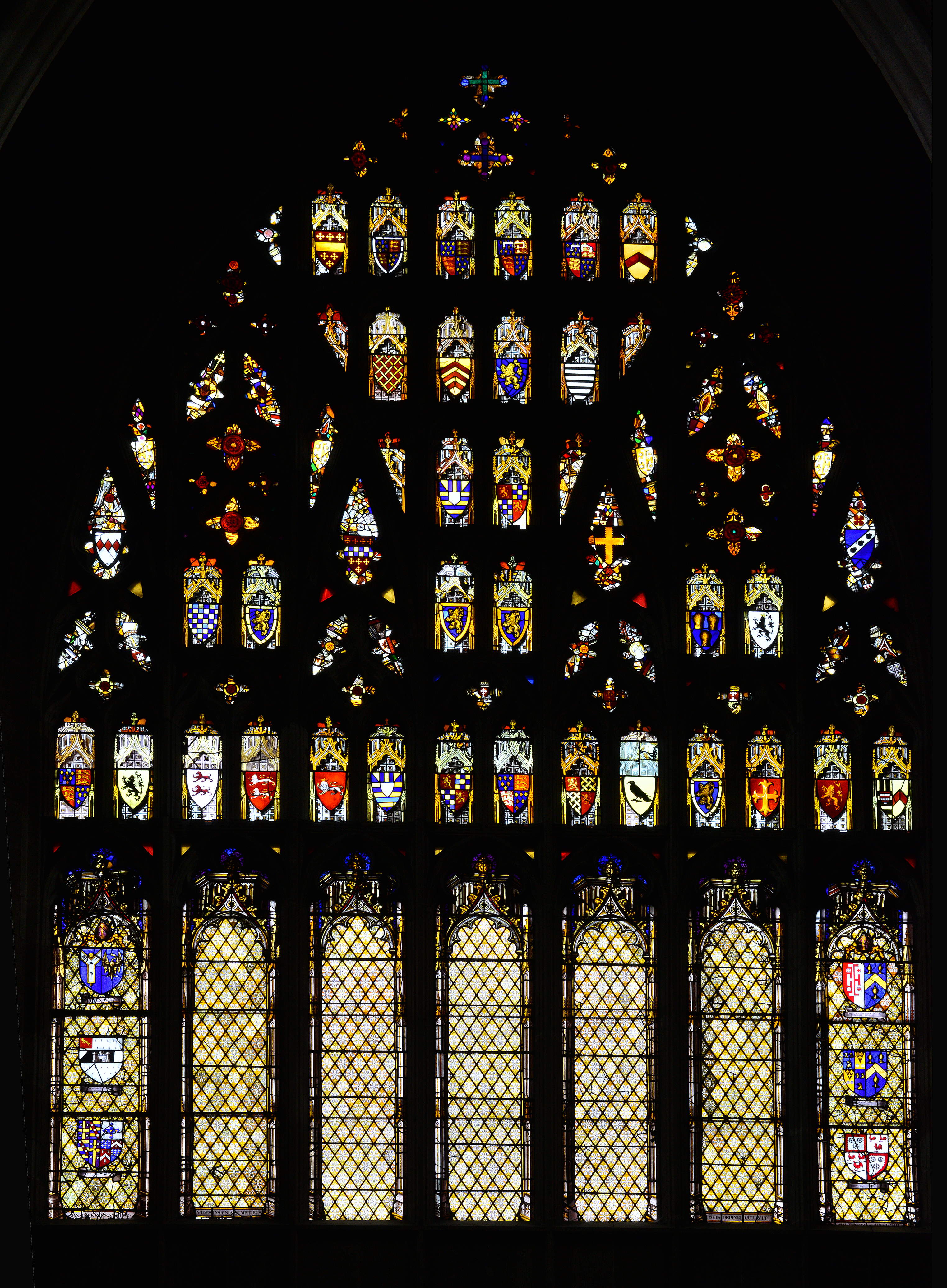
English studio, west
window of heraldic badges and
quarry patterns, 1814, Abbey
Church of Saint Peter and Saint
Paul, Shrewsbury (Shrewsbury
Abby), Shropshire, England.
Photo: Michel M. Raguinaccompanied by heraldic display. Pugin provided the designs and they were fabricated by William Wailes in 1844. The coat of arms carries the emblem of the martlet, a mythical bird that was popular in heraldic devices. Surrounding the shield is Pugin’s motto en avant (forward) using the French nomenclatures traditional to heraldry. Such heraldic display was also common in religious settings even as the first glimmering of the ecclesiastic revival began. Shrewsbury Abbey’s massive west window was given new glass in 1814, apparently replacing earlier work of similar design. The heraldic badges fill the tracery lights and lancets furthest to the right and left. Quarries embellished with neutral-colored paint and yellow silver stain in the center let in a wealth of light.
Imports and domestic products
This kind of glazing was some of the first attempted in the United States. Imports, then, and throughout the 19th-century, competed with native products, as exemplified by the grisaille glazing with medallions purchased from Bristol, England, in 1860 for the Church of the Holy Comforter (Episcopal) in Poughkeepsie, New York.8 Such windows parallel the earliest grisaille work in England such as the quarry design window of St. George and the Dragon by C. Edwin Gwilt, of 1840, now Victoria and Albert Museum.9 It is a consistent option offered by the studio catalogues, for example, Heaton and Butler's 1860 issue. The same kind of glazing of grisaille quarries with emblems 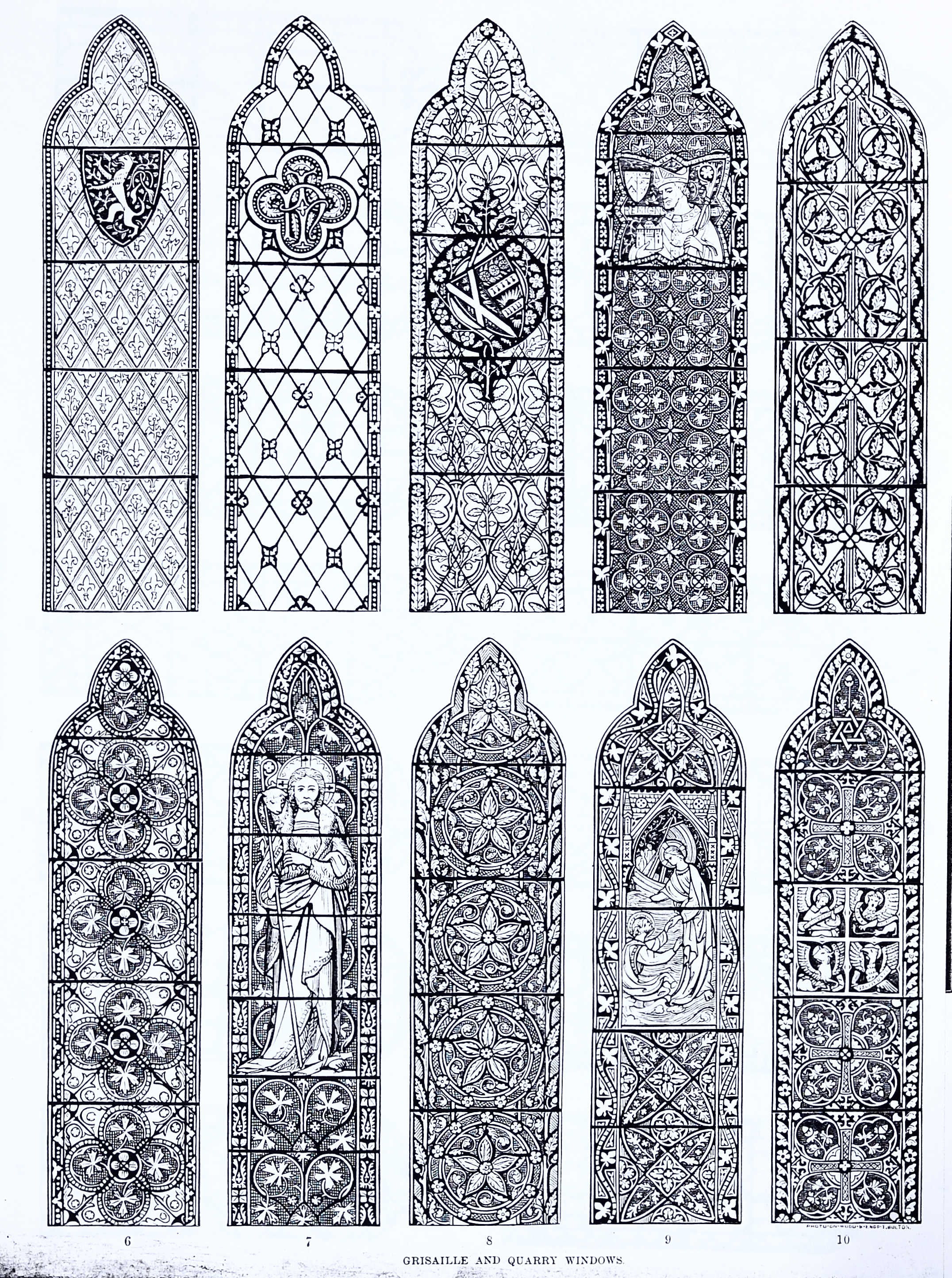
Heaton and Butler,
London, grisaille and quarry
windows from Sales Catalogue,
1860. was installed in St. Paul's, Burlington, as part of Hopkins' 1851 renovation campaign, so that we can conclude that the style met with his approval.10 The system has remained a viable and popular choice throughout the history of American stained glass by foreign and by American studios.
John L. Race, of the New England Glass Company: Boston in the early 19th century
One of the earliest records of true stained and leaded windows, however, is not from a
John L. Race, New England Glass
Company, East Cambridge, glass dome
of Tremont House, Boston, 1829, after
William H. Eliot, A Description of
Tremont House (Boston, 1830)
color pl. IX.religious building, but a commercial one, the glass dome of Tremont House, Boston. Built in 1829 and regarded as a landmark building of a luxury hotel, it marked the city’s efforts to become a cultural capital and welcome international visitors. The building was designed by Isaiah Rogers in a classical style and the five-foot diameter dome accented the circular entrance hall. John L. Race, of the New England Glass Company, East Cambridge, designed and constructed a stained glass skylight that was the first of its kind in New England. The contemporary description states that the "designs were partly copied from the fresco paintings of the Baths of Titus, which are supposed to have suggested to Raphael the composition of his celebrated Arabesques in the Vatican."11 The dissemination of such models through printed sources seems incontrovertible. Designs for the glass could very well have depended on publications such as Nicolas Ponce's, Arabesque antiques des bains de Livie,......(Paris, 1789) containing Raphael's designs and examples from Roman antiquity.12
Isaiah Rogers, Tremont House, Boston,
1829, after William H. Eliot, A Description of
Tremont House (Boston, 1830) pl. VIThe New England Stained Glass Company had exhibited glass at the Franklin Institute Competition in 1827. An 1829 advertisement stated that the company could produce "stain glass after the ancient mode of doing that work, for Churches, Dwellings &c."13 In 1829 Harvey Redding, the forerunner of Redding, Baird & Co., also began the production of stained glass windows and his products were noted at the 1839 Mechanic's Fair. Race, who trained abroad, presumably in England, was working at the New England Stained Glass Manufactory in Boston by 1834 where he had instructed William Redding in "Staining Glass in the Ancient Style."14 Race's early work is typical of his time. His techniques are traditional in the material construction of the window, yet his motifs owe more to High Renaissance models. The brilliantly colored mixture of foliage, grotesques, classical urns and affronting birds form a highly attractive pattern. In figural as well as decorative work, the conservative taste of the American patrons would encourage the retention of Renaissance forms, even when mixed with medieval elements.
Influence of England’s Ecclesiological Society in America
During the 1840s and 50s a concern for accuracy and authenticity was a strong force in church construction.15 This direction reflected the influence of English ecclesiastical reform movements transplanted to American congregations. The Cambridge Camden Society, later renamed the Ecclesiological Society, endeavored to promote architectural design that would enhance liturgically oriented space, with clearly defined areas that reflected increased religious ritual.16 The Ecclesiologists developed an increasingly narrow definition of the ideal medieval models and demanded a high level of accuracy in their replication. They favored at first English Perpendicular but later restricted the choice to the Decorated Style of about 1300, especially as reflected in the English parish church. Similar theoretical constructs reappeared later. Definitions as rigid as those of the Ecclesiologists, although concerning different models, were also to become part of the discourse in the renewed interest the Gothic in the 20th century.
Trinity Church, Episcopal, New York, Richard Upjohn, architect
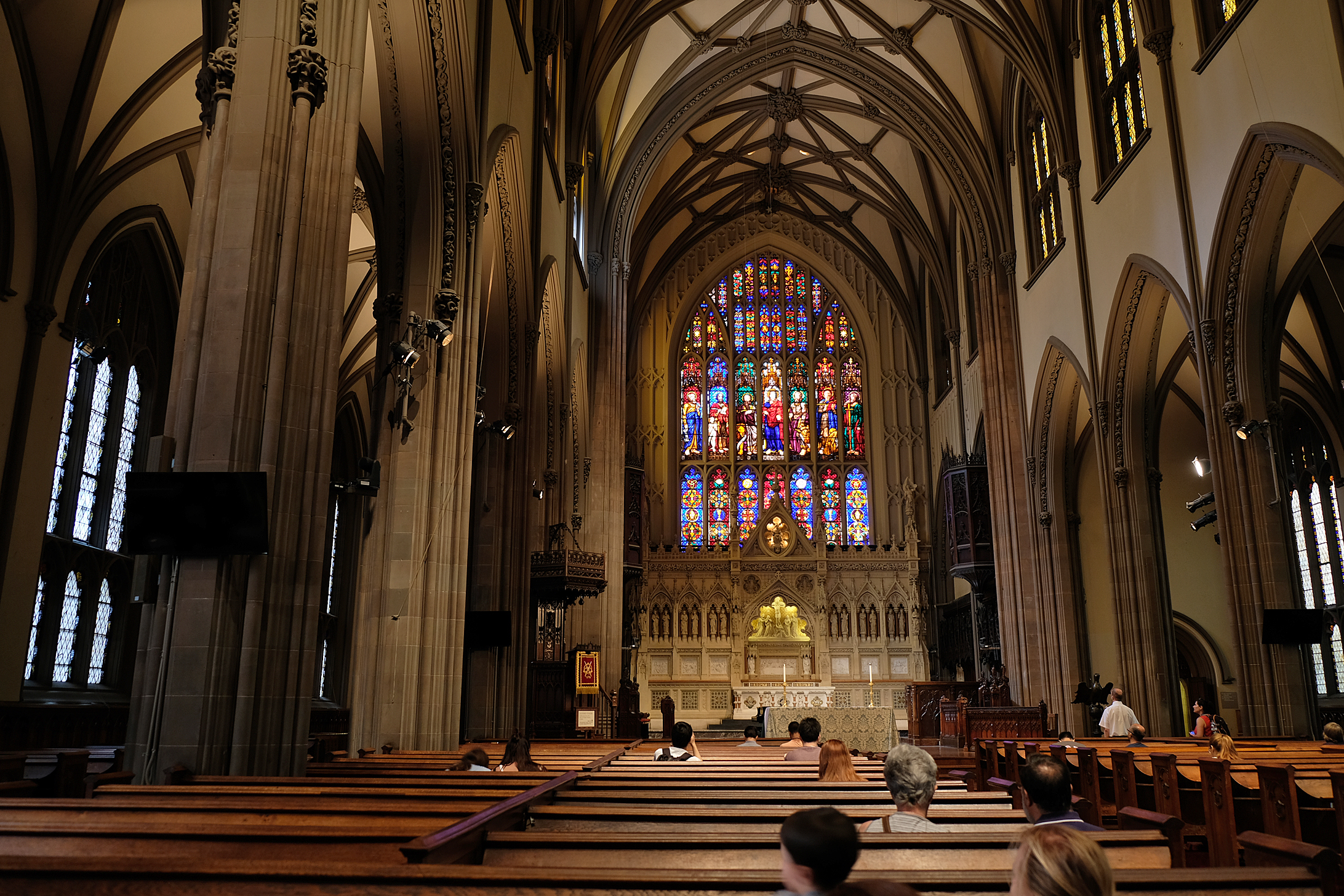
Richard Upjohn, Trinity Church,
Episcopal, Broadway, New York; Abner
Stevenson, chancel window depicting Christ
flanked the four evangelists and saints
Peter and Paul, 1844-1845.
Photo: authorRichard Upjohn, one the premier architects of his time, was inspired by August W. N. Pugin's writings before 1840 in his design for Trinity Church, Episcopal, New York.17 Trinity was finished in 1846 in the English Perpendicular Gothic style, the historicizing mode then advocated by Pugin as ideally suited to church building. Galleries, so common to Georgian buildings, had been eliminated. A raised chancel area reflected the liturgical requirements of the prevailing English taste. Upjohn himself provided the Gothic Revival design for the chancel window executed by Abner Stevenson from 1844 through 1846.18 The Upjohn/Stevenson window (see detail) presents Christ flanked by figures of the four evangelists and saints Peter and Paul under Gothic canopies. The splendid series of figures from an Apostles’ Creed window probably made for Hereford Cathedral about 1420 at the Museum of Fine Arts, Boston, demonstrates the long tradition of this format.19 The single figure under a canopy, complemented by non-figural designs either in grisaille or pot metal glass, became the standard mode of much figural glass painting at mid-century.
St. James the Less, Philadelphia, the English country church model
St. James the Less, Episcopal,
Philadelphia, 1846-1850, exterior, east,
showing three lancet windows above the
altar. Photo: authorThe construction of St. James the Less, Philadelphia, also Episcopal, from 1846 to 1850 marked the later stage of Ecclesiological influence.20 The transfer of an ideal design source for St. James reveals the influence of Samuel Farmar Jarvis, the second Episcopal bishop of Connecticut. Jarvis has been a member of the faculty of the General Theological Seminary in New York and had lived for an extended period in Europe pursuing study of language and the history of the church. In 1844 he was in England, became friendly with members of the Cambridge Camden Society, and obtained from them plans of St. Michael's, Long
St. Michael's, Long Stanton,
Cambridgeshire, dating from about 1230.
Photo: lain99 Stanton, Cambridgeshire, an unusually pristine example of a rural parish church dating from about 1230.21 Although generally recommending the more elaborate Decorated Style of the later part of the 13th century, the Ecclesiologists decided to urge an Early English model whose fieldstone walls, and plan of nave flanked by north and south aisles, a chancel and a south porch made it more suitable for limited funds and restricted construction expertise.
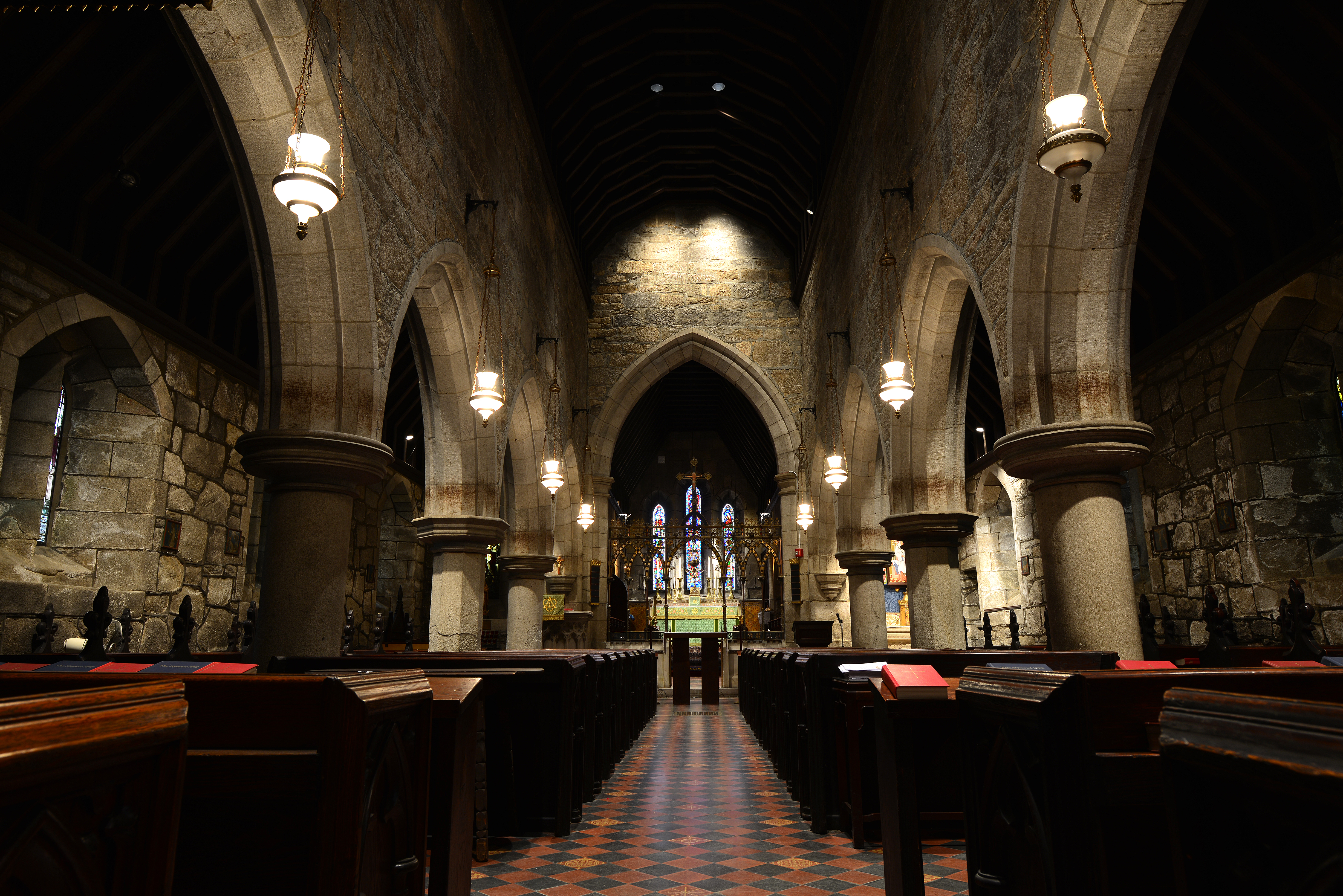
St. James the Less, Episcopal,
Philadelphia, 1846-1850, interior, towards
east. Photo: Michel M. Raguin Jarvis was friendly with Robert Ralston, a wealthy merchant living in a rapidly developing suburb of Philadelphia, which was in need of a parish church. Jarvis sent the plans of St. Michael's to Ralston, who corresponded extensively with him during the planning and construction of the building. Ralston also received the Reverend W. R. King, a member of the Ecclesiological Society who was passing through Philadelphia in 1846, and immersed himself in Ecclesiological literature. He ultimately corresponded with the Reverend Benjamin Webb, who with John Mason Neale, had been the principal champions of the movement. The vestry approved the plans for St. James the Less with the stipulation that the buildings would not cost more than $3,000.22 This sum doubled within a few months at Ralston's recommendation and because of the decision to increase the length of the church one bay and to add a vestry on the northeast side of the chancel. With the exception of these details, St. James the Less is a faithful replica of the Early English model. The pulpit, lectern, rail between nave and chancel and the window sash were to be imported from England. Ralston had been concerned with the unplastered and unpainted interior of the building as recommended by the English correspondents, but was reassured by the aesthetic judgment of Major Douglass, past professor of architecture and civil engineering at the University of the City of New York. The Philadelphian soon became deeply committed to the use of natural materials, specifying that there would be "fine cut stone . . . best seasoned oak, no plaster no paint about the church."23 Ralston contributed a major share of the expenses of the church.
Henri Gérente,
Story of
Moses, Ely
Cathedral, England,
1849,
Photo: internetAA33. The windows above the high altar, completed in 1849, were produced in France, but by individuals with family and commercial ties to England. [See Appendix] The signature ALFRED GERENTE PARIS 1849 appears below St. Matthew at the bottom of the right lancet. An earlier notice in the Ecclesiologist spoke of the completion of the building "for which a stained glass east window will be obtained (probably) from M.
Alfred Gérente Studio,
St. Matthew, detail of
Tree of Jesse
chancel window, 1849,
Photo: internet
Gerente [sic]."24 Alfred was the inheritor of his brother, Henri Gérente, an unusually adept artist. Gérente's knowledge of iconography and medieval draftsmanship made him appear to his architect patrons as the hope for a rebirth of the medieval aesthetic. Henri began his career in 1841 and by 1845-1846 restored the windows of the cathedral of St.-Jean in Lyon; from 1846 to 1848 he made five windows for the chevet of St.-Germain-des-Prés; in 1847 he won the much publicized competition for the commission to restore the Ste.-Chapelle; and in 1848 he provided three windows for Ely Cathedral, England.25 He even employed paint in a matte effect to suggest the patination acquired by age in genuine medieval glass.26
The tall narrow lancets of the chancel contain a Tree of Jesse, a subject as traditional as its style. We see depicted the lineage of Christ based on the Prophesy of Isaiah that "there shall come forth a rod out of the root of Jesse" (Isaiah 11:1). The image shows kings of the Old Testament seated within tendrils of a vine that springs from the recumbent figure of the patriarch Jesse.27 The style is a meticulous reproduction of an early 13th-century mode. Blue and red, the typical stained glass palette of France, dominate the
Alfred Gérente Studio,
Jesse with monogram of
Alfred Gérente, detail of
Tree of Jesse chancel
window, 1849.
Photo: Michel M. Raguinwindow. The single figures are silhouetted against an unmodulated background and perform stylized gestures. The garments are constructed of solid pot metal colors on which are applied simple strokes of the grisaille paint in linear patterns. Three-dimensionality is scrupulously avoided. We also find a sensitive effort to make the image appear to have lived for centuries. As already noted in the windows produced for Ely, the painting of the glass suggests the degradation of the glass surface, and the accumulation of surface grim that was visibly a part of antique windows. The face of St. Matthew, for example, is modeled with a coarse matt, with highlights removes with a stiff brush. His garments, a green tunic and russet cloak, show two shades of paint, a medium value and a fully saturated trace applied as lines to indicate folds. Over this graphic, the artist flecked a pattern of spattered paint, emulating the appearance of 13th-century glass that has withstood seven centuries of weather. The blue backgrounds are even more modulated, with paint in dark masses near the edges of the leads, as if indicating the accumulation of dirt.
Church of the Holy Trinity, Brooklyn: Minard Lafever and William Jay Bolton
Minard Lafever's Episcopal church of the Holy Trinity, Brooklyn, built between 1843 and 1847, was also 
Minard Lafever, Church of St. Ann and
the Holy Trinity, Episcopal, Brooklyn, nave
looking east, 1843-1847. Photo: authorinfluenced by the Ecclesiologist movement.28 Its original design was in the Perpendicular Style but as construction progressed Lafever incorporated more of the Decorated Style into the work, particularly evident in details of capitals and corbel supports seen in the gallery. The stained glass program [See Appendix], the first major commission on American soil, however, was not in the same historical style as the building. William Jay and John Bolton who both designed and executed the windows were influenced by the early 16th-century style of glazing in King's College, Cambridge that they had known from their youth. A known and physically proximate authority took precedence over a remote and theoretical one.
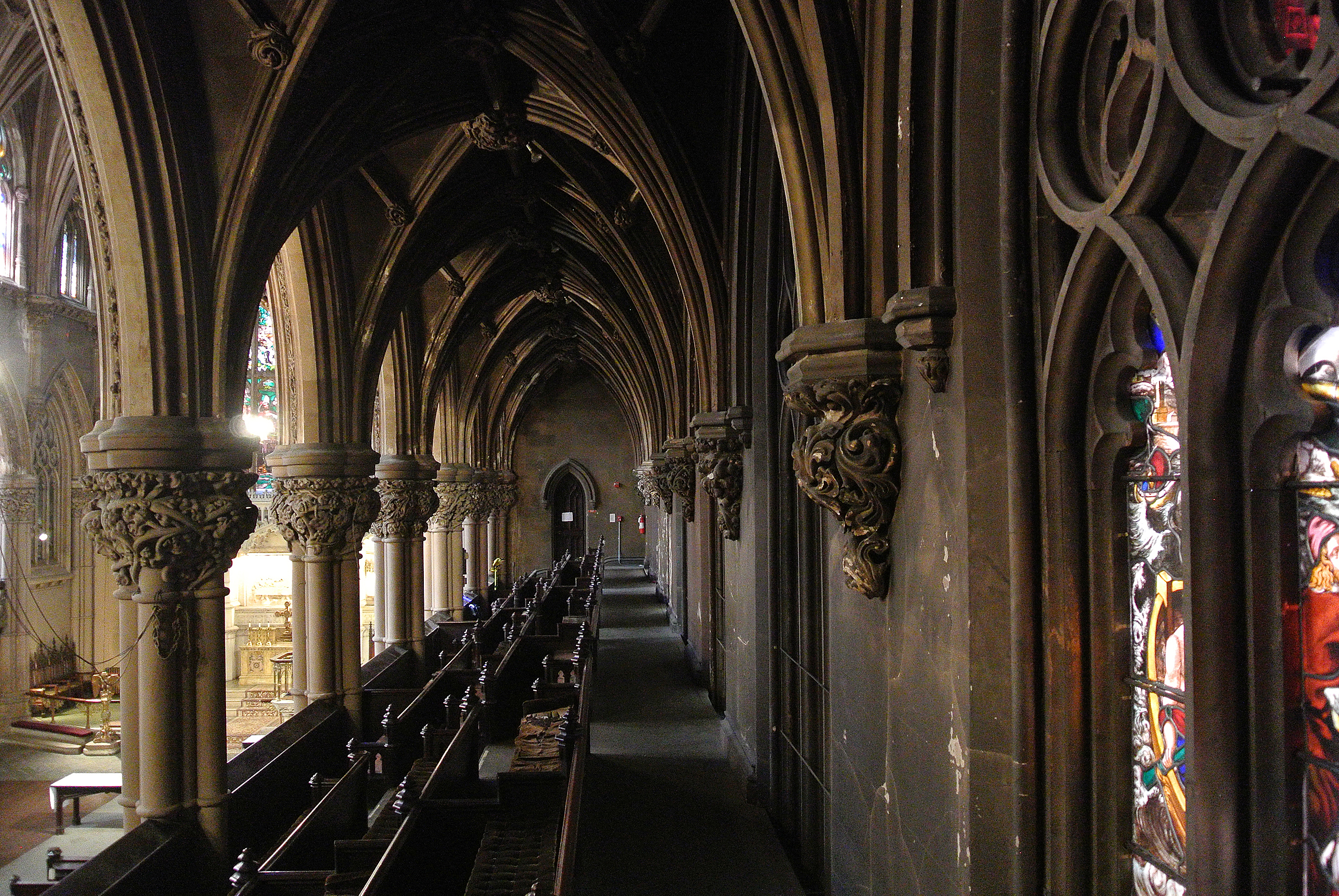
Minard Lafever, Church of St. Ann and
the Holy Trinity, Episcopal, Brooklyn, south
gallery, level for window of the Life of Christ,
1843-1847. Photo: authorThe context of the Boltons' commission and their training reveals much of what was typical of their time. Robert Bolton, William Jay and John's father, was a representative of a Savanna cotton company who married Ann Jay, daughter of a prominent Evangelical Anglican minister. The family settled in Bath, England and the young Bolton grew up under the influence of his grandfather and father, who had also taken holy orders. During his school holidays William came to know King's College while visiting his aunt Arabella Jay in Cambridge.29 When William Jay was twenty Robert Bolton moved his family to Pelham, New York, just outside of New York City. Washington Irving was a close neighbor. The Boltons constructed a mansion in Gothic Revival style that they named "The Priory" and a family church, now Christ Church, Pelham. For the Boltons, patronage, artistry, and religion were combined. William Jay had begun painting while still in England and in America enrolled in Samuel F. B. Morse's courses at the National Academy of Design. In 1840 he received the Academy's first prize for a drawing after a cast of the Venus de' Medici. He returned to Europe and toured both England and the Continent, returning in 1842. Presumably on this trip he gained not only additional artistic education but guidance in the technique of producing painted and leaded windows. He set up a glazing kiln in a shed behind The Priory and in 1843 began to produce the first of the windows that now fill Lafever's church. Bolton's own writing reflects general attitudes concerning the revival of stained glass in Europe. He believed that his century could surpass the art of the past. "If Gothic we must have, let it be an enlightened, progressive, 19th-century Gothic. . .when we possess better materials, a less superstitious religion, and a more cheerful taste, with all the experience and examples of the past to guide and correct."30
The Inspiration of King's College Cambridge
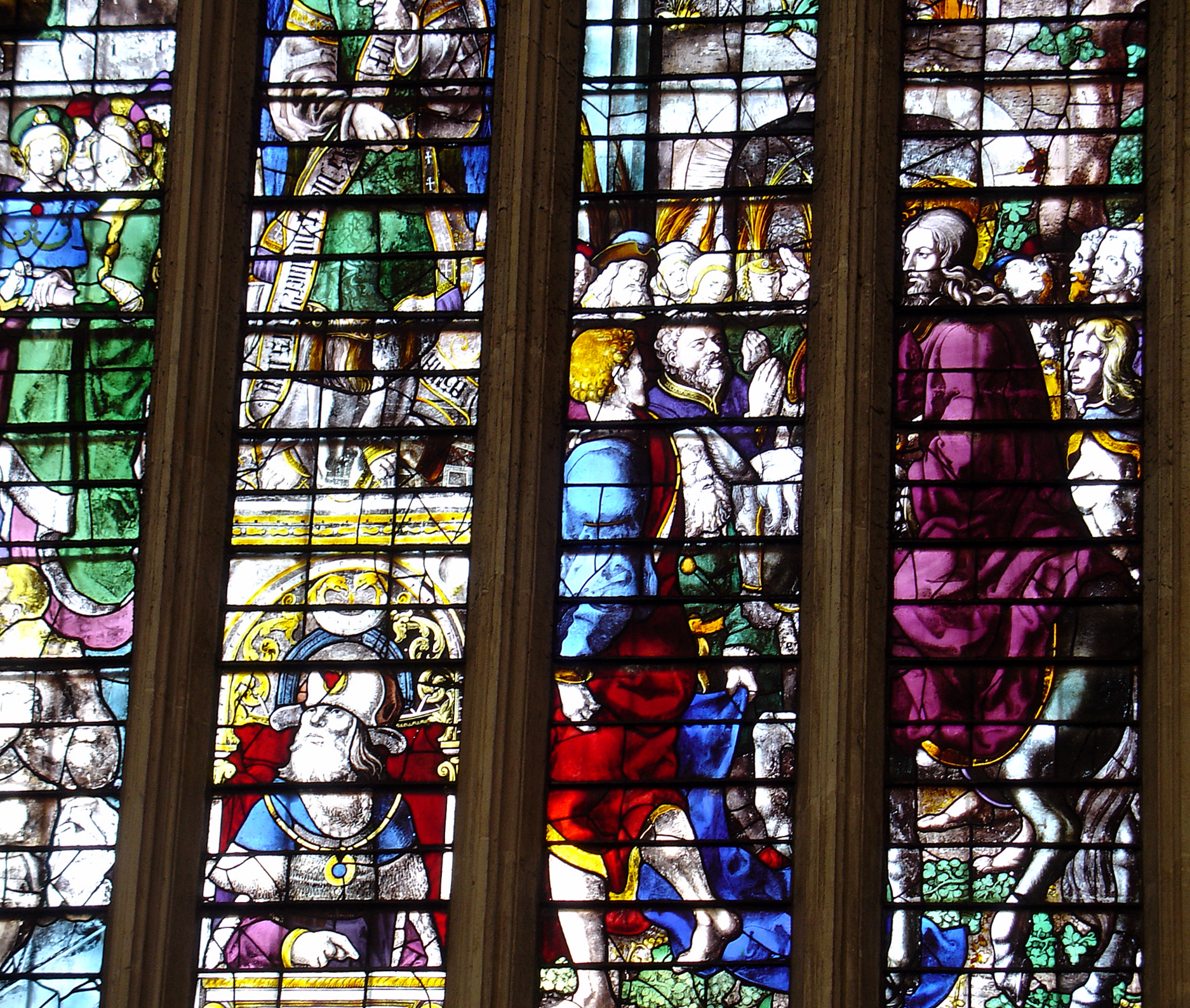
Dierick Vellert, Entrance into Jerusalem,
1525-1545, King’s College Chapel. Cambridge,
England, window 8. Photo: author William Jay was inspired by both the iconography and the style of the 
William Jay Bolton, Entrance into
Jerusalem, Church of St. Ann and the Holy
Trinity Brooklyn, 1844-1848.
Photo: Michel M. Raguinwindows in King's, most of which were designed by the Lowlands artist, Dierick Vellert.31 Bolton thus incorporated what we now term Northern Renaissance style into a late Gothic building. Vellert is now studied as a major Lowlands printmaker and designer of panels and glass, influenced by Dürer and the Italian Renaissance. To the mid-19th century, however, he represented the last and greatest phase of a medieval tradition, orchestrating scenes with large numbers of three-dimensional figures against vast architectural backdrops. Bolton's Christ’s Entrance into Jerusalem reflects the same acceptance of the depth and pictorial tradition. Bolton adapted the compositions from the immense windows at King's and restructured the iconography to fit the smaller openings and more intimate spaces of Lafever's building.
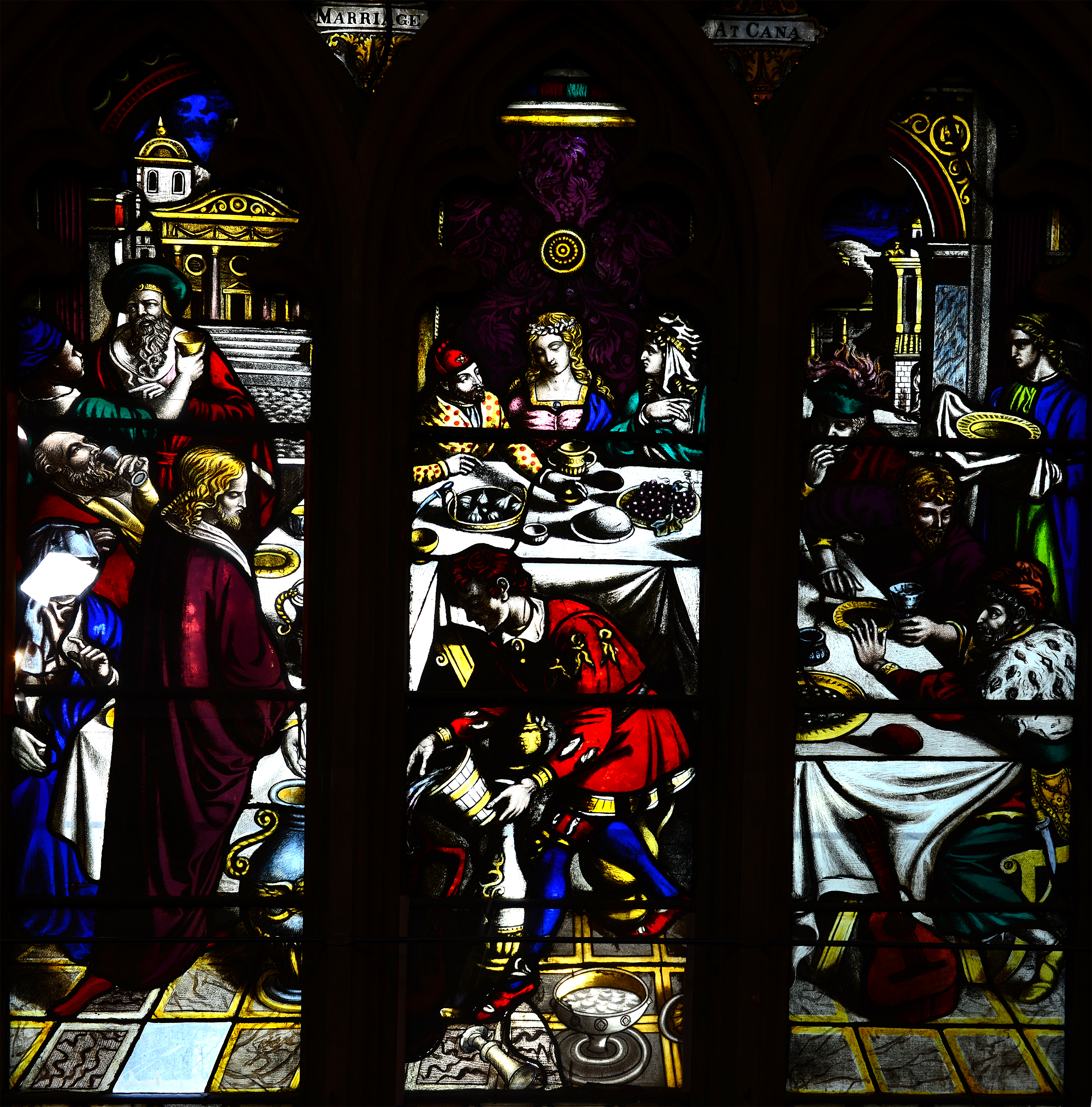
William Jay Bolton, Wedding Feast at
Cana, Church of St. Ann and the Holy Trinity
Brooklyn, 1844-1848.
Photo: Michel M. RaguinKing's College contrasted the Old and New Testaments in a complex narrative, a common medieval and Renaissance theme. The two tiers of huge five-lancet window apportioned the Old Testament on the top and the New Testament at the bottom, separated and supported by images of the angels and prophets in the center and below. The apportioning of window space in Lafever’s building with three separate levels of glazing necessitated a new arrangement. The upper (clerestory) windows present themes from the Old Testament, those of the gallery level, the Life of Christ, and the aisle windows a Tree of Jesse.The Wedding Feast at Cana, which is not depicted in King's, exemplifies the dynamics of the narrative which Bolton manages within the three-lancet format. The center frames a young servant directly in front of the table set before the bride. Vividly dressed in blue stockings, red shoes, and a tunic of red potmetal glass, abraded to show golden ribbon ties at the shoulder and slashes at the for forearm, he captures the viewer’s attention. Christ is to the left, with golden silver-stain hair and wearing a deep purple robe. Behind him the wine steward gestures to the host that the wine has run out. To the right the revelers continue to eat and drink. The suggestion of opulence is enhanced by the facades of the Renaissance architecture in the background and the details of food, drink, and décor such as the marbleized tiles of the floor.
The theme of the Jesse Tree, already discussed for the chancel window of St. James the Less, presented a 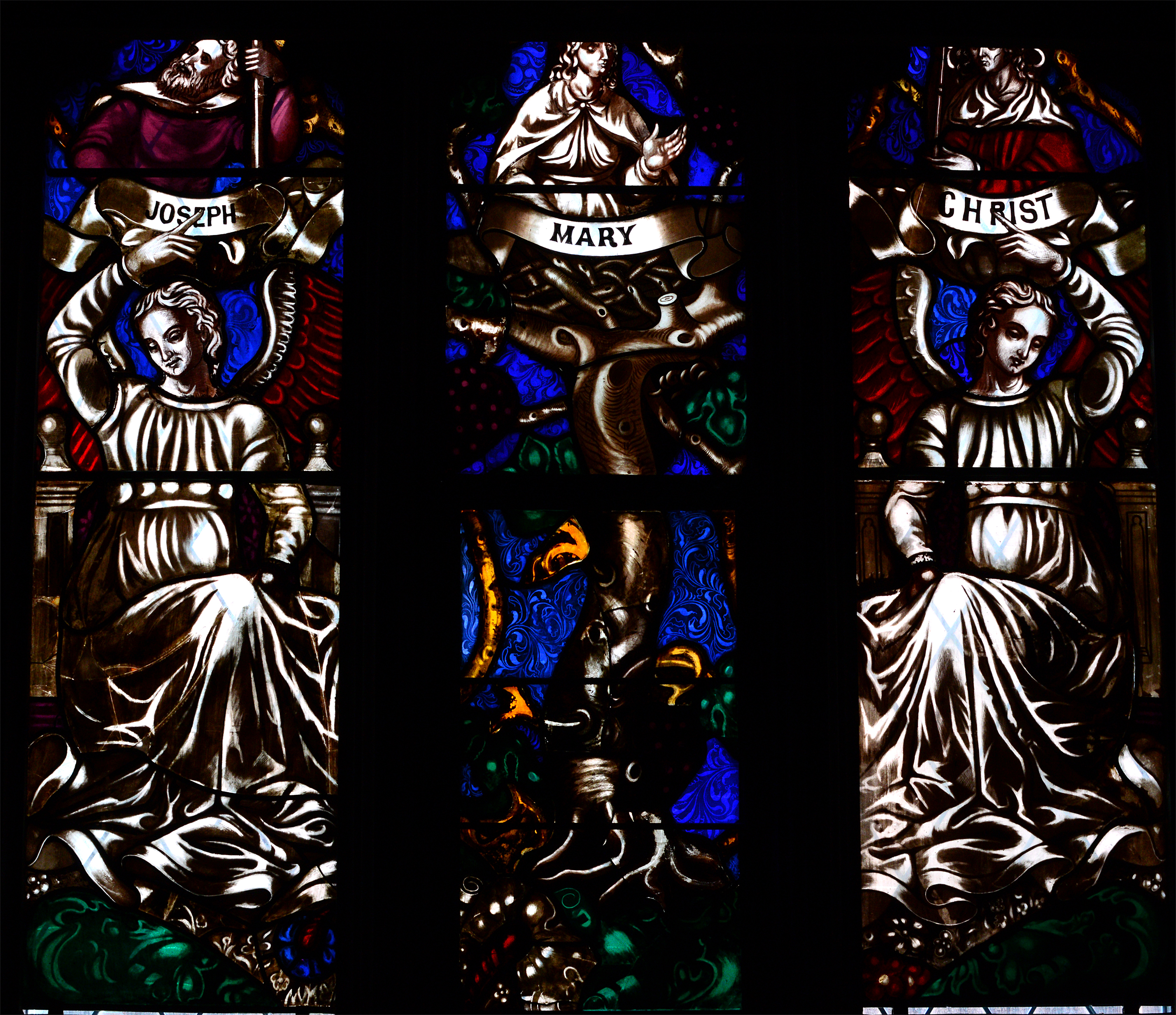
William Jay Bolton, Joseph, Mary, and
Christ: Tree of Jesse, Church of St. Ann
and the Holy Trinity Brooklyn, 1844-1848.
Photo: Michel M. Raguinsystem for profiling the lineage of Christ that had been popular since the 12th century. Bolton designed the series with tri-lobed tops in symmetric arrangement. In all windows he placed the trunk of a tree whose branches frame portrait-busts identified by inscriptions on banderols. In the lancets to the left and right, angels point to the busts. The window showing Joseph, Mary, and Christ concludes the series and is placed closest to the chancel. In this culminating scene, the angels are seated on Renaissance-style benches.
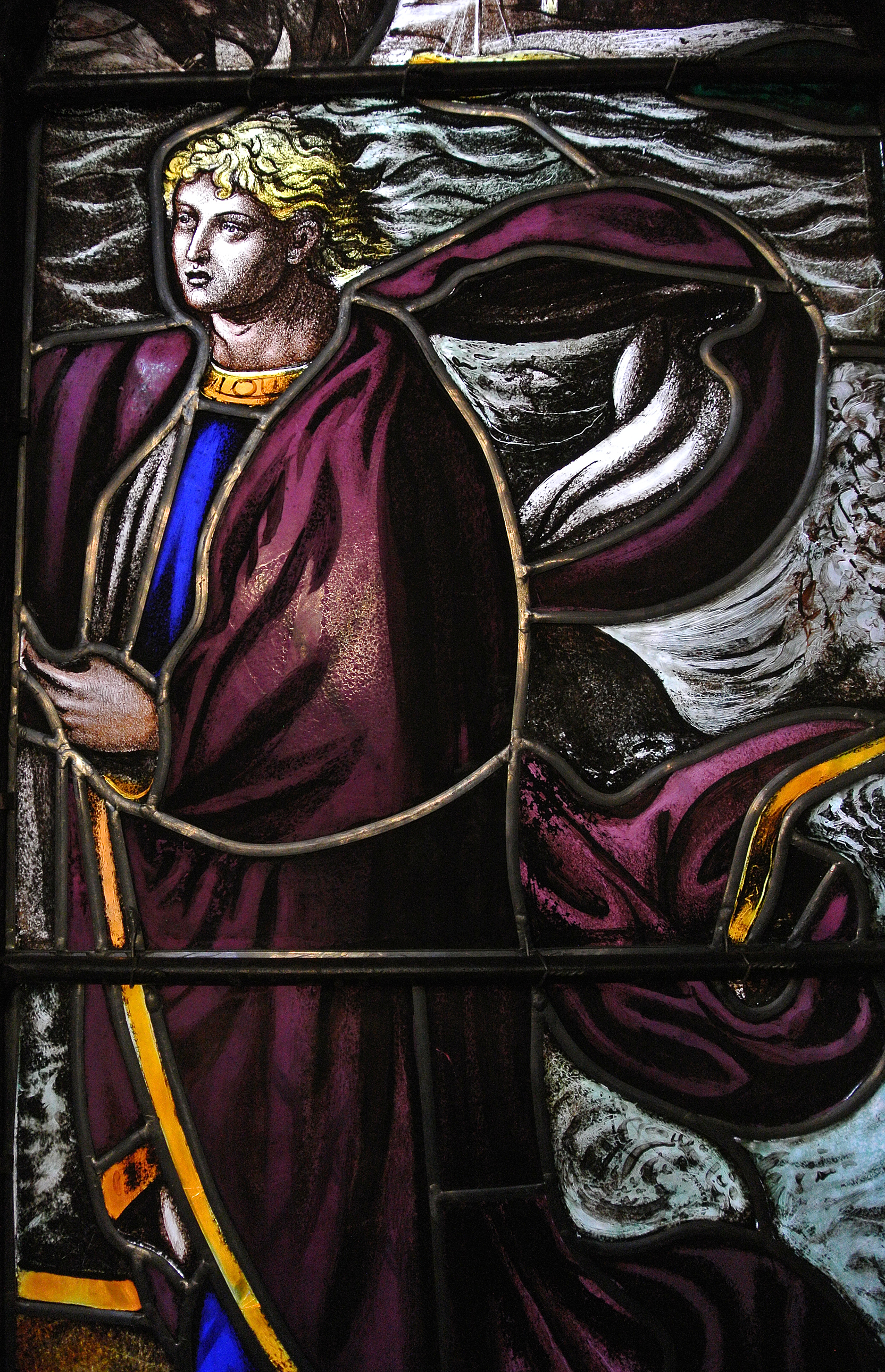
William Jay Bolton, Christ
Calms to Sea, detail of the
Apostle John, Church of St. Ann
and the Holy Trinity Brooklyn,
1844-1848.
Photo: Michel M. Raguin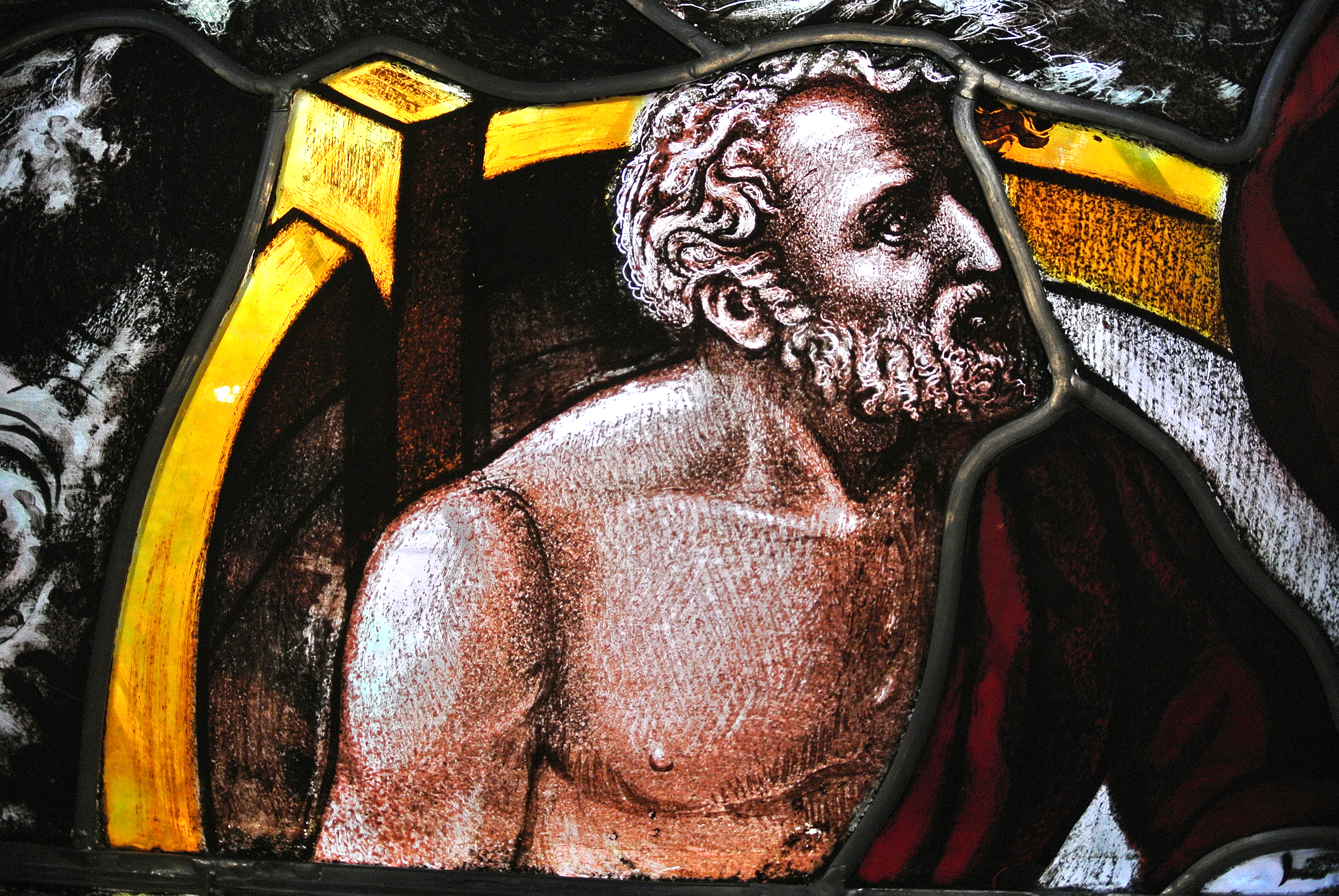
William Jay Bolton, Christ Calms the Sea,
detail of the Apostle Peter, Church of St. Ann
and the Holy Trinity Brooklyn, 1844-1848.
Photo: Michel M. RaguinSignificantly, one of the major forces in the revival of stained glass in England, Charles Winston had criticized King's College Chapel for what he felt were its use of too complicated compositions overcrowded with figures extending into the extreme distance.32 Bolton's adaptations are simpler and more easily read from a distance. Bolton also adapted a painting style and brushwork that took into account the difference of scale between the easel work or drawing to which he had been accustomed. The windows exhibit broad sweeps of smear shading and bold hatch 
William Jay Bolton,
Life of Christ,
1846-1848, Church
of the Holy Apostles,
New York work to model the forms. This is particularly visible in the organ loft window, now installed in the garden court of the Metropolitan Museum.33 The Brooklyn program was an extraordinary achievement; more than fifty windows designed, painted, and installed within eight years. It remains today, even in the context of contemporaneous European programs, as a major monument of post-medieval glazing.
The architect and the makers of stained glass; flexible modes of eclectic revival
The flexibility of patron and architect, and the eclectic diversity of the era is evident even from the few commissions during the decade of the Bolton brothers' activity.34 Bolton provided a series of windows in a wholly different format for the Church of the Holy Apostles in Manhattan.35 Lafever built Holy Apostles between 1846 and 1848 in an Italianate, often called Tuscan, Renaissance Revival style. Bolton's windows consist of small circular medallions containing a painted roundel, a single pane of glass executed in neutral trace line and silver stain. A lush adaptation of classical foliage motifs surrounds each medallion and functions as a transition to the square format of the three panels in each lancet. Inscriptions above each panel identify the iconography depicted in the roundels.36 This roundel design was based on Bolton’s knowledge of the Renaissance roundel imported from the Continent during the first half of the 19th century and installed in many English churches. A roundel from the book of Daniel showing Susannah and The Elders, dated abut 1520, now in the Cloisters, New York, illustrates the generic inspiration. Like the roundels in Bolton’s windows, the South Netherlandish work show similar realistic treatment of landscape and figures. The roundel functions aesthetically as a drawing on glass that can retain a viewer’s interest in the delight of draftsmanship as well as iconographic subtleties and yet function within a decorative frame of window glazing, in Bolton’s decision, embellished with floral motifs.37 The versatile eclecticism of Lafever himself, as well as that of his glass designer, deserves comment. Not only did the architect design equally well in the Renaissance and Gothic modes, but his Whaler's Church in Sag Harbor, Long Island (New York), with its great pylon facade in wood, is an oft-cited example of Egyptian revival.38
REFERENCES
1. ^ Waldron Phoenix Belknap, Jr., American Colonial Painting: Materials for a History (Cambridge MA, 1959), 63-75, 273-322. Belknap also documents the career of Everet Duykink, a Dutch immigrant New York glazier of the 17th century. Jules Prown examines Copley's sources in John Singleton Copley (Cambridge Massachusetts, 1966), 15-19, figs. 7-17.
2. ^ Hopkins 1836. Bishop Hopkins (1792-1868) wrote a number of important statements against the Cambridge tractarians and abolitionists. Significantly, he was not an ardent proponent of high church trappings (see his essay The Law of Ritualism, etc. (New York, 1866), but saw that there would be a general increase in liturgical embellishment, "for the spirit of the age will favor it, because it is an age of excitement...; it appeals with far more effect to the natural tastes and feeling of humanity." Ibid., p. 94.
3. ^ Hopkins 1836, p. 13, also cited by Clark 1979, p. 32.
4. ^ In describing the previous state of the building, the New York Ecclesiologist 4 (1852), 192, recorded that the "windows were covered by muslin screens, painted either by the Bishop himself or by members of his family." The original church of St. Paul's was lost in a fire of 1971. I am grateful to Anne Brown of the Burlington Episcopal Diocesan Center for responding to my inquiries.
5. ^ Hopkins 1836, p. 15.
6. ^ Hopkins 1836, p. 15.
7. ^ "Pugin saw that...the methods of building of the Middle Ages must be revived: architecture must again derive its character...from the direct expression of structure; and at the same time it must serve the complicated ritual-functional need of revived medieval church practices," Hitchcock [1958] 1963, p. 97. See especially Paul Atterbury and Clive Wainright eds., Pugin: A Gothic Passion (New Haven, 1994).
8. ^ The Church of the Holy Comforter, designed by Richard Upjohn, is on the National Register of Historic Places and church records note the purchase. The window has four lancets and figural imagery in the tracery, but otherwise is in the same tradition of neutral quarry glazing with color accents. I am grateful to E. Sue Lumb, former professor of Biology Vassar College, who organized a survey, symposium, and tour of stained glass of Poughkeepsie in 1985/6, accomplished with the support of the Cuneen-Hackett Cultural Center, Inc. Fred Maddocks documented a series of buildings in photographs.
9. ^ Harrison 1980, color pl. 2b. See also Joseph Hale Miller's Four Apostles window in the church of the Holy Trinity in Tunbridge Wells, England of 1839, Ibid., fig. 5.
10. ^ "At the top of the head (of the chancel window) is the tetragrammaton in a triangle, and glory. Below, in the next two openings, are two red crosses. In the heads of the four bays are medallions, with emblems of the Passion. The rest of the window is filled with good rich mosaic of antique pattern." New York Ecclesiologist 4 (1852), 194.
11. ^ William H. Eliot, A Description of Tremont House (Gray and Bowen: Boston, 1830), 8-9, color pl. IX. I thank Arlene Palmer Schwind who cited this commission in The Glass Club Bulletin 166 (1988), 2, for bringing these notices to my attention.
12. ^ See Hetty Joyce, "Nicolas Ponce's 'Arabesque Antiques': A Problem in Eighteenth-Century Archeology," Gazette des Beaux-Arts, 4th ser., 104 (1989), 181-201.
13. ^ Watkins 1930, p. 69.
14. ^ Watkins 1930, pp. 69-70. See also Evening Gazette, September 28, 1839.
15. ^ Stanton 1968, and critique of the reception of Upjohn and ecclesiastical Gothic by James Patrick, "Ecclesiological Gothic in the Antebellum South," Winterthur Portfolio 15/2 (1980), 117-38.
16. ^ Kenneth Clark, The Gothic Revival (3rd ed.) (London: John Murray, 1962), pp. 170–73.
17. ^ Stanton 1968, pp. 60-9; Upjohn [1936] 1968, pp. 47-67, fig. 16 for interior view of chancel. Also, for a well-illustrated survey of furniture and glass vessels in the Gothic Revival style, see Katherine S. Howe and David B. Warren, The Gothic Revival Style in America 1830-1870 [exh. cat. Museum of Fine Arts, Houston] (Houston, 1976).
18. ^ See Sturm 1982, pp. 16-18, fig. 15. Julie L. Sloan, “The richest colors imaginable': The Stained Glass of Trinity Episcopal Church, Wall Street, New York (1846)” The Journal of Stained Glass, vol. 36 (2012): 56-77. This in-depth study recounts the process of selecting the studio and in determining the kind of glass required. All the windows receive laudable attention, including the many quarry windows with silver-stain decoration. The author adds that there is no indication that the windows were intended as temporary glazing. Rather, the schema apportioned a harmonious balance of figural and non-figural windows to achieve a well-illuminated but richly colored interior.
19. ^ The dominance of deeply saturated pot metal colors was unusual. For the most part, Upjohn's Gothic-revival churches were glazed, even in the chancel, with patterned white glass only accented with color. See St. John's Church, Bangor, Maine (1836-9) [Upjohn 1936, pp. 44-8, fig. 9]; First Parish Church, Brunswick, Maine (1845-46) [Upjohn 1936, pp. 73, 91, fig. 24]; St. James Church, New London, Connecticut (1847-50) [Upjohn 1936, pp. 76-9, fig. 30]; St. Pauls' Church, Buffalo (1850-51) [Upjohn 1936, pp. 95-9, fig. 55). More elaborate glazing showing standing figures silhouetted against grisaille patterns appears in the chancel of St. Paul's Church, Brooklyn (1859-60) [Upjohn 1936, pp. 175, 199, fig. 94]. See window originaly from Hereford Cathedral as a model. Marie Antoinette Evans Fund 25-213. Each of the figures carries a banderole with a segment of the prayer the Apostles Creed. Each of the eight saints appears against a brilliant colored damascene background framed by elaborate Gothic architectural forms of shimmering white glass touched with gold. The window is not complete, giving evidence that the glass must have been made for a larger window, Hereford Cathedral: Madeline Caviness in Corpus Vitrearum Checklist I, pp. 44-45
20. ^ Stanton 1968, pp. 91-115. I am deeply appreciative for assistance on this topic from Jean Farnsworth with whom I first visited St. James the Less.
21. ^ The church was declared redundant in 1973 and is now managed by the Churches Conservation Trust.
22. ^ When all the interior funishings, including the earliest windows, had been provided, the church cost $30,000. Stanton 1968, p. 106. For other windows see Appendix.
23. ^ Discussion of contract in letter from Ralston to Jarvis, October 15, 1846, Connecticut State Library Collection, Hartford, Connecticut, as quoted in Stanton 1968, p. 103, n. 17.
24. ^ Ecclesiologist 9 (April, 1849), 351. See discussion of the glass in Stanton 1968, pp. 106-107. The vestry minutes of Sept. 9, 1850 note "Thanks of vestry be presented to Henry Farnum Esq. for his very beautiful and appropriate present of an East window. [I thank Jean Farnsworth for communicating this information.]
25. ^ "Nouvelles," Annales archéologiques 1 (1844), 418-9. For Lyon, see Brisac 1980, p. 73, and Lucien Bégule, Monographie de la cathédrale de Lyon (Lyon, 1880), 155. For St.-Germain-des-Prés, see Inventaire des richesses de la France, vol. 1 (Paris, 1876), 1. Gérente used the cartoons of Hippolyte Flandrin, who had executed the murals of the church. For the Ste.-Chapelle, see Jeanette Dyer Spencer, "Les vitraux de la Ste.-Chapelle de Paris," Bulletin monumental 99 (1932), 341-2, and Taralon, Vitrail, p. 277. Gérente was selected from 25 competitors. Bouchon, International Seminar 1994, 69-75. See also the obituary for Henri Gérente in Ecclesiologist 10 (1849), 97-101.
26. ^ Harrison 1980, pp. 24-25, fig. 23
27. ^ The image appeared in the Ile-de-France in the 1140s and enjoyed an immense popularity in a generally unvarying format throughout the 13th century. Arthur Watson, The Early Iconography of the Tree of Jesse (Oxford, 1934).
28. ^ The name was changed with the merger of the parishes of St. Ann and Holy Trinity in 1969. Landy 1970, esp. 105-131. See also Roscoe C. E. Brown, Church of the Holy Trinity, Brooklyn Heights in the City of New York 1847-1922 (New York, 1922).
29. ^ Grace Bolton, William's daughter, "Notes", written after 1922, now King's College Library, Cambridge, cited in Clark 1979, p. 34, n. 12.
30. ^ William J. Bolton, "Architecture and its Connection with Religion," The Christian Advocate and Review, 2d ser., 6:69 (1872), pp. 838-39, as quoted in Clark 1992, p. 52.
31. ^ A study of the program and styles of King's College is found in Hilary Wayment, The Windows of King's College Chapel, Cambridge, Corpus Vitrearum Medii Aevi, Great Britain, Supplementary vol. 1 (London, 1972).
32. ^ Bolton must have been aware of Winston's opinions via his publications appearing since 1838. A posthumous collection groups most of this work: Mémoirs Illustrative of the Art of Glass Painting (London, 1865), The opinion of King's is on p. 316. See also Winston 1847, p. 177. Winston compared them to those of the great Renaissance programs of Liège. He found them "weaker" but taken collectively they "form indeed the most important specimen of the Cinque Cento style in the country." Bolton published his own analysis as "King's College Chapel Windows, Cambridge," Archaeological Journal 12 (1855), 153-72. See also for Bolton's attitudes about the Cinque Cento style, Clark 1992, pp. 50-3.
33. ^ (L. 1985.136) Blocked by the organ for some years, the window was removed in 1985 and is now on loan (installed in the court of the American Wing) to the Metropolitan Museum of Art. Clark 1992, pp. 110-1, fig. 45.
34. ^ Bolton settled in Cambridge, England in 1848 producing windows and repairing glass in King College Chapel. He received a Master's degree from the University in 1856, was ordained, and does not appear to have continued working in stained glass after 1850. Clark 1979, p. 53; Idem., "A William Jay Bolton Window Discovered: 'The Angel at the Tomb' at West Lynn, Norfolk," The Journal of Stained Glass 18/1 (1983-84), 52-57; Clark 1992, pp. 26-30, 67-68, 117-19, figs. 55-57, pl. X. I am deeply grateful to Willene Clark for her review of this chapter and for her help with photographs.
35. ^ Landy 1970, pp. 147-58; Clark 1979, p. 53, fig. 24.
36. ^ Clark 1992, pp. 66-67, 111-16, figs. 47-54, including tracing made by Bolton of roundel attributed to Dierick Vellert installed in Holy Trinity Church of Stratford-on-Avon.
37. ^ For an overview of the roundel see Timothy B. Husband, The Luminous Images: Painted Glass Roundels in the Lowands, 1480-1560 [exh. cat. The Metropolitan Museum of Art] (New York, 1995). For the importation of Continental work to England see Jean Lafond, "The Traffic in Old Stained Glass from Abroad during the 18th and 19th centuries in England,”Journal of the British Society of Master Glass-Painters 14/1 (1964): 58-67.
38. ^ Landy 1970, pp. 225-35. See throughout for discussion of Lafever's ability to work in a wide variety of styles, including the Greek revival style used for the Reformed Dutch Church in Brooklyn.